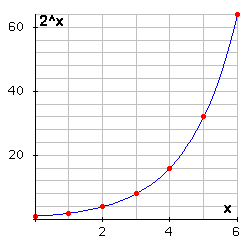Sections 9A,9B
Functions, Linear Functions.
...
Generalities
The notion of function is designed to express the idea of dependency.
Specifically, a quantity depends on another one.
The change of one of them yields a change of the other.
Example: bacteria in a bottle.
The amount of bacteria changes with time.
Terminology
The two quantities are called variables.
A function describes how does dependent variable changes
when/if independent variable chages takes place.
Example: bacteria in a bottle.
Elapsed time since 11am is independent variable
Amount of bacterias is dependent variable.
Ways to present a function.
- mathematical formula
- graph
- data table
Formula in the example with bacteria in a bottle
\(N=2^t\)
Independent variable -- t -- time in minutes after 11:00am
Dependent variable -- N -- number of bacterias
Advantage of formula: easy to calculate
Disadvantage of formula: difficult to imagine
Graph in the example with bacteria in a bottle

Advantage of graph: easy to imagine
Disadvantage of graph: inaccurate readings
Data Table in the example with bacteria in a bottle
may be produced out of the formula \(N=2^t\),same applies to the graph:
| Elapsed time, t | Amount of bacterias, N |
|---|---|
| 0 | 1 |
| 1 | 2 |
| 2 | 4 |
| 3 | 8 |
| 4 | 16 |
| 5 | 32 |
| 6 | 64 |
Modeling our world
VERY ROUGHLY
One starts with an idea that there may be a dependency between two quantities.
One collects raw data, possibly organized into a data table
One draws a graph from this data table in order to visualize it
One tries to figure out a formula for the function whose graph is close to this one
This function is a model for the dependency
Simplest class of functions -- Linear Functions
Linear Modeling -- modeling with linear functions
For a function, one may ask how does the dependent variable change when the independent variable changes by a unit
\( \text{rate of change} = \frac{\text{change in dependent variable}}{\text{change in independent variable}} \)
Linear function has constant rate of change
Linear function has constant rate of change.

A car is traveling along the road with a speed of 60 mph. The distance of this car to its destination point depends on time. This distance is a linear function in time. It decreases by 60 miles every hour. That is its constant rate of change of -60.
Formula:
distance to destination = initial distance -60 \(\times\) time.
Linear Functions. General Formula
\(y=mx + b\)
was in example:
distance to destination = initial distance -60 \(\times\) time.
\(x\) - independent variable (was time)
\(y\) - dependent variable (was distance to destination)
\(m\) - rate of change aka slope of the graph (was speed of -60 mph)
\(b\) - initial value aka y-intercept on the graph (was 400 miles)
Concluding remarks
The graph of every linear function is a straight line
The slope of this line \( slope = \frac{\text{change in y}}{\text{change in x}} \)
indicates how much the dependent variable \(y\) changes when the independent variable \(x\) changes by 1.
However,
not every straight line can be a graph of a linear function.
Exception: vertical lines are not!
 They represent no dependency at all.
Instead of showing how \(y\) depends on \(x\)
this graph indicates that \(x\) does not depend on \(y\).
They represent no dependency at all.
Instead of showing how \(y\) depends on \(x\)
this graph indicates that \(x\) does not depend on \(y\).